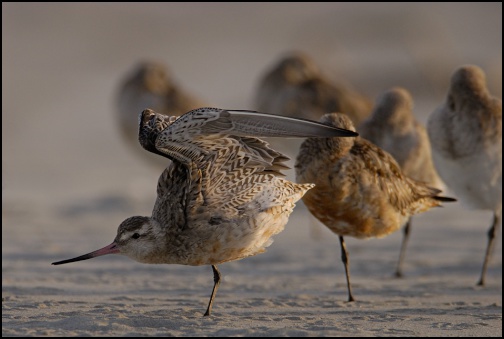Bar-tailed godwit (kuaka) crowned Bird of the Year
Bar-tailed godwit (kuaka) crowned Bird of the Year
26 October 2015
The bar-tailed godwit (kuaka) has been crowned New Zealand's Bird of the Year after three weeks of close competition, heated campaigning and scandal.
These lunatic long-distance fliers have the longest migratory flight of any bird in the world, and travel over 11,000 kilometres from Alaska to reach New Zealand in less than 9 days.
Between 80,000 - 100,000 godwits begin arriving in the country from late September with most heading for the Kaipara and Manukau harbours, the Firth of Thames, Farewell Spit, and the Avon–Heathcote estuary.
Campaign manager for the bar-tailed godwit, Keith Woodley from the Pukorokoro Miranda Shorebird Centre, says the long flight takes its toll and birds will lose half their body weight during the trip.
"When they get here, they look absolutely exhausted. The first thing they do is have a drink to rehydrate and then they go to sleep. Eventually, they start feeding to make up for the huge amount of weight they lose during their flight." said Woodley.
However, being tired is the least of the godwit's problems, as their numbers are dropping.
"Godwits coming to New Zealand from Alaska are declining by 2% a year" says Keith Woodley.

"Habitat loss is a massive problem for these birds, especially in east Asia where most of them stop to refuel. And of course, like many of our native species, climate change will pose challenges for them as well."
Keith hopes the Bird of the Year title will raise awareness for the godwit, other shorebirds and threats to their habitat. He says it fits perfectly with the Pukorokoro Miranda Shorebird Centre's 'Year of the Godwit' theme.
"This year is actually our 40th anniversary and we have been celebrating with a 'Year of the Godwit' theme, so it's fitting that these long-haul champions have also been crowned the 2015 Bird of the Year!"
Bird of the Year
is one of Forest & Bird’s most popular annual events. It
aims to raise awareness of New Zealand’s unique native
birds and the threats they face by asking people to vote for
their favourite species. This year saw over 13,000 people
vote for their favourite bird, with the kōkako coming in a
close second with 1814 votes followed by the kākā with 988
votes.
ENDS


 NIWA: Antarctic Footprint Clean-up Challenges - How A Remote Antarctic Base Clean-up Protected One Of Earth’s Clearest Lakes
NIWA: Antarctic Footprint Clean-up Challenges - How A Remote Antarctic Base Clean-up Protected One Of Earth’s Clearest Lakes Hugh Grant: Can A Meme Coin Become A Real Payment Solution?
Hugh Grant: Can A Meme Coin Become A Real Payment Solution? Imported Motor Vehicle Industry Association: EV Battery Fires Expose New Zealand Regulatory Gap
Imported Motor Vehicle Industry Association: EV Battery Fires Expose New Zealand Regulatory Gap  Electricity Authority: Electricity Authority Welcomes Plan To Empower Consumers And ‘Make NZ More Electric’
Electricity Authority: Electricity Authority Welcomes Plan To Empower Consumers And ‘Make NZ More Electric’ Pamu Farms: New Zealand Farm Dog Genetic Study Shows Top Five Health Risks
Pamu Farms: New Zealand Farm Dog Genetic Study Shows Top Five Health Risks EDANZ: Payments NZ Forcing The World’s Most Aggressive Removal Of EFTPOS Terminals
EDANZ: Payments NZ Forcing The World’s Most Aggressive Removal Of EFTPOS Terminals


